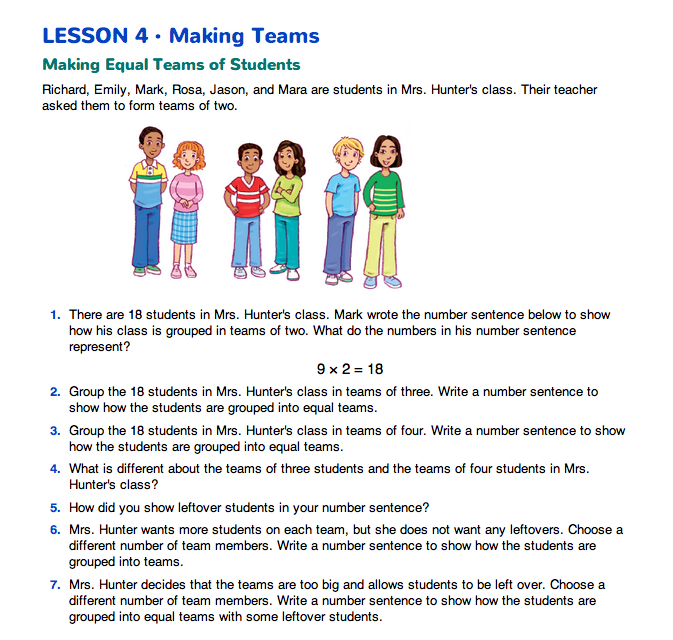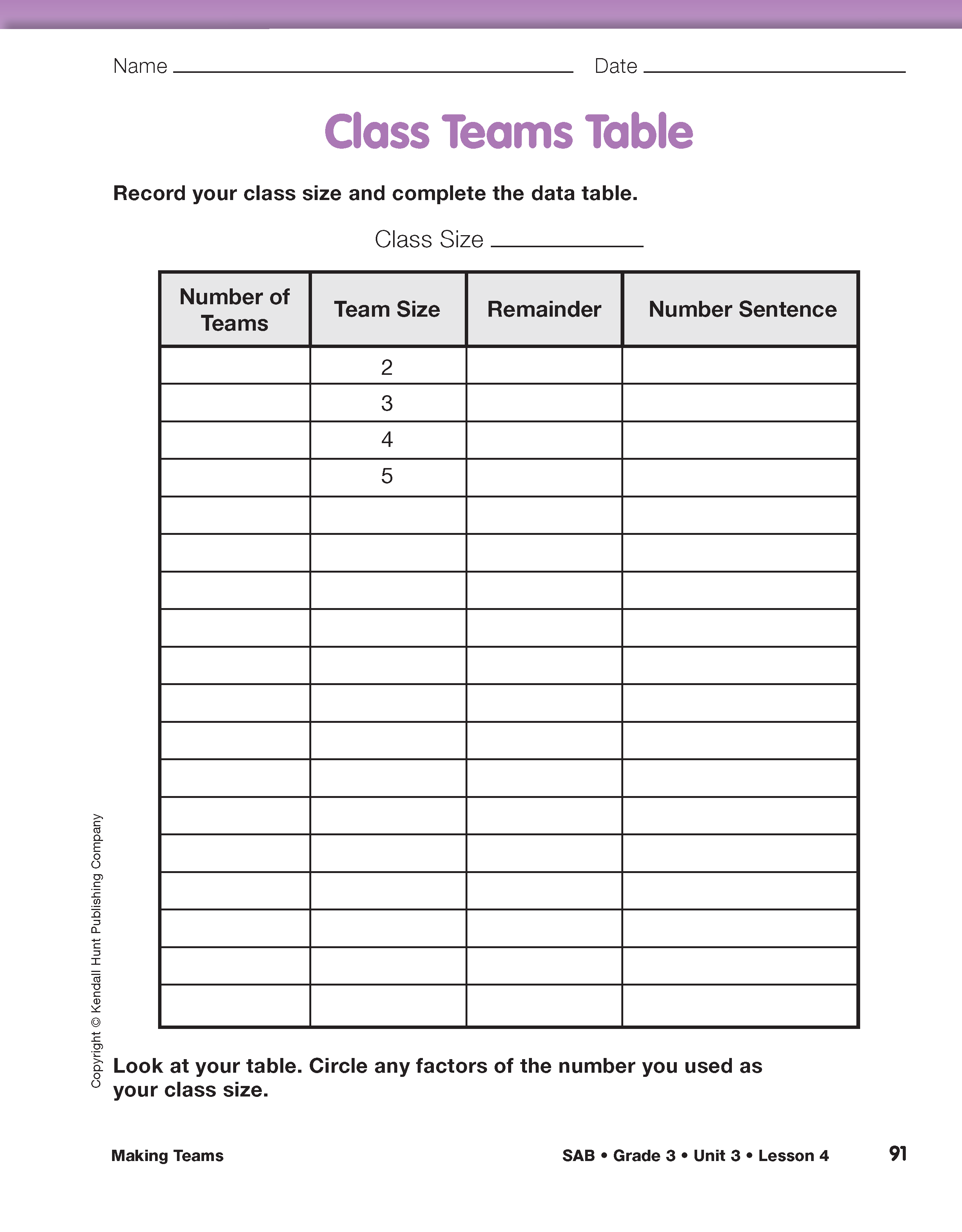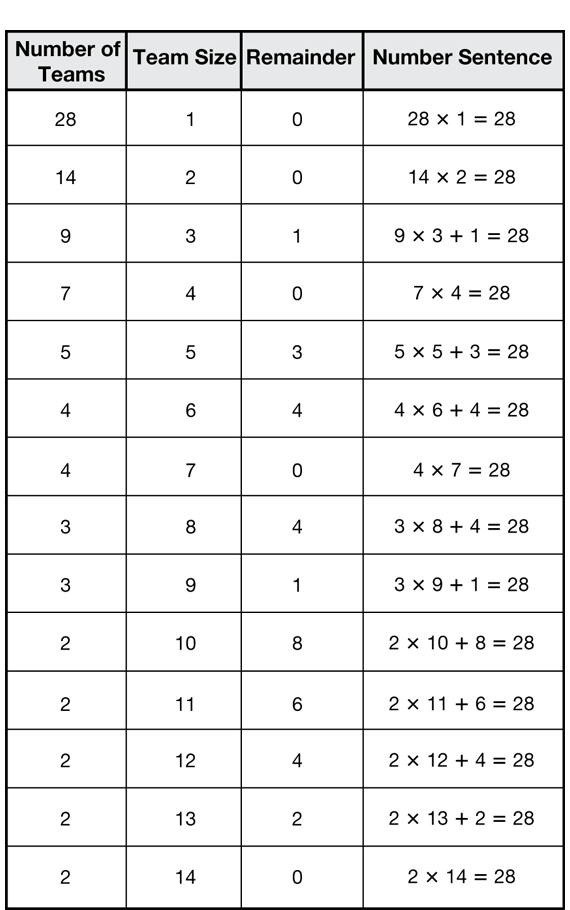Making Teams
Est. Class Sessions: 1Developing the Lesson
Make Equal Teams in Your Class. Explain that in this activity you will explore ways to divide the class into equal teams. You will pick a number and have students group themselves into teams of that size.
Choose a number that is a factor of the number of students in the class. For example, if you have 28 students, you can choose 2, 4, 7, or 14. If you choose 4, students will make seven teams with four students on each team. If the class size has no factors to choose for team size because it is a prime number, include yourself in the activity and form teams of 2.
For each team size, ask students to suggest a number sentence that shows the teams. Display all suggestions. If students suggest only addition sentences, for example, 4 + 4 + 4 + 4 + 4 + 4 + 4 = 28, encourage them to also write a number sentence that involves multiplication: 7 × 4 = 28.
Have students form teams of several different sizes, with no leftovers. Ask students for number sentences to represent each configuration of teams, encouraging multiplication if they do not offer it on their own.
For example, you might ask:
After students have formed all of the possible teams with no leftovers, make a list of all the factors used.
Make Equal Teams of Students with Some Left Over. Next, pick a number that is not a factor of the class size and have students form teams, this time with leftovers. For example, if you have 28 students, you might pick 3. Students would then form 9 teams of 3 with 1 student left over. Ask students to form teams of several numbers that result in leftovers, eliciting number sentences from students each time. Continue to encourage multiplication if students do not volunteer it, although in this case you will have to use a combination of multiplication and addition to represent the way in which students are grouped. For example, the above grouping could be represented with the number sentence 1 + 9 × 3 = 28. See Content Note on order of operations.
Make Equal Teams in Mrs. Hunter's Class. Refer students to the Making Teams pages in the Student Guide. Introduce Mrs. Hunter's task of dividing the students into teams by discussing the vignette using the following questions.
Ask:
Distribute counters and ask students to answer Questions 1–5. Use the context of Mrs. Hunter's class to continue the discussion of making teams. In Question 1, Mark uses the number sentence 9 × 2 = 18 to show the 18 students in the classroom divided into nine equal teams of two. Students should recognize that the nine tells how many teams, the two tells how many students are on each team, and the 18 tells the total number of students in the class.
Question 2 asks students to form teams of three. Since you can form six equal teams of three, the number sentence for Question 2 will be 6 teams × 3 students = 18 students.
In Questions 3–5, students are asked to form teams that will result in some students being “left over.” As students begin to form the teams of four asked for in Question 3, they will find that there will be two students who will be “left over” after the teams have been formed. Use the following prompts to help students understand how to represent this situation using a number sentence that includes both multiplication and addition.
Ask:
Display the number sentence 4 × 4 + ![]() = 18.
= 18.
Ask:
After students seem to have the context, ask pairs to read and find solutions to Questions 6–7.
Find the Factors of 18. Ask students to look at the Finding the Factors of 18 section in the Student Guide. The vignette that introduces this section continues the exploration of making teams in Mrs. Hunter's classroom and introduces the Mrs. Hunter's Class Teams Table. In Question 8, students are asked to find four ways to divide 18 into equal teams without remainders. Using the chart, students should identify nine teams of two; six teams of three; three teams of six; and two teams of nine as the four possible ways to make teams without remainders (leftovers).
Ms. Hunter identifies the numbers 2, 3, 6, and 9 as factors of 18 and defines factors as numbers you multiply together to get a product. A factor of a number can also divide that quantity into equal-size groups without leftovers. Using this definition, students are asked to identify 1 and 18 as the other two factors of 18 in Question 9.
Use Counters. In this part, students will model the team-making activity with counters that represent students. They will divide the counters into groups that represent teams of various sizes.
Divide students into pairs. Give each student pair the number of counters equal to the number of students in the class. Assign each pair a different team size and ask them to arrange counters into teams of that size and leftovers. Explain that leftover counters can also be called remainders—the extra counters that remain after the others have been divided into teams. Ask students to help you write a number sentence for each team size; e.g., 7 teams of 2 students is 7 × 2 = 14.
Work through several different team sizes as a class, then ask students to explore sizes with their partner and record their findings in the Class Teams Table in the Student Activity Book.
Complete the Class Teams Table. Students should complete the table's second column before they begin their investigations. The first few team sizes have been filled in as an example. (It may seem unusual to list the team size in the second column instead of the first, since that is the number known first. That is so the order of the columns matches the order of the numbers in the related number sentences.)
Work through several different team sizes as a class. As students complete the “Number Sentence” column for each example you do as a class, point out the correlation between the number sentence and the grouping it represents.
For example, you may ask questions such as:
Use questions like this to develop the idea that 6 × 4 + 1 can be read as “six groups of four and one leftover.” This will be especially helpful for students who struggle with making the connection between the concrete (actual students in the class), the hands-on but still more symbolic (counters or beans), and the abstract (number sentence) representations of the concepts involved in this lesson. See Content Note on order of operations.
Students should explore all the possible team sizes for the class.
Encourage the use of counters to help students find and model their solutions. Students should record their findings. The data table will be complete when they have exhausted all team sizes for which they can make at least two teams. A completed table for a class of 28 students is shown in Figure 1.
You may want to guide students in organizing their lists. They could, for instance, begin with a team size of one, then consider a team size of two, and so on. If they do this, they will find it easier to see the patterns in their data. However, you may prefer to be less directive and let them discover for themselves the value of organizing data systematically.
If some students finish before others, suggest that they work on a similar problem using a different class size.


















